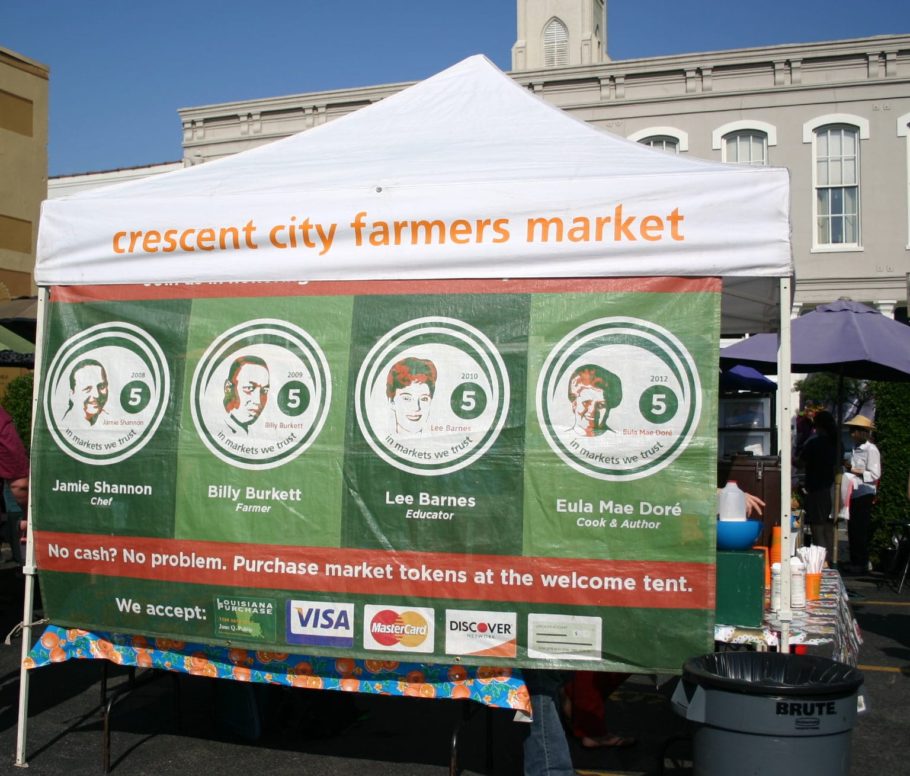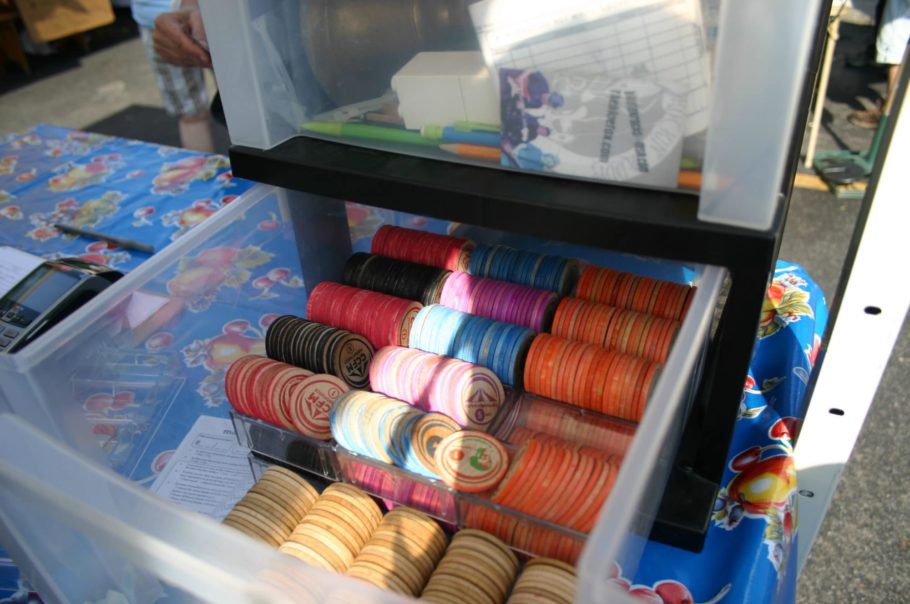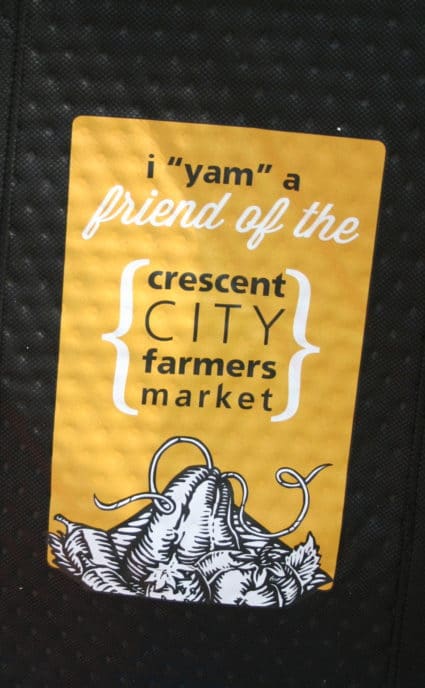How a Market Currency System Enabled One Market to Accept SNAP Benefits and Credit Card Payments
Crescent City Farmers Market (operated by the organization Market Umbrella) uses a market currency system to accommodate customers paying with credit cards, debit cards, or SNAP benefits.
The Customer Experience
A customer who wishes to pay with plastic (whether credit, debit, or SNAP/EBT cards) visits the Welcome Tent before shopping at vendor stalls. At the Welcome Tent, a market staff member swipes the customer’s card for whatever amount the customer chooses to convert to market currency. The staff member then issues the customer the appropriate quantity of wooden tokens, which can be redeemed like cash at vendor stalls.
 Photo credit: Erin Buckwalter, NOFA-VT
Photo credit: Erin Buckwalter, NOFA-VTCrescent City Farmers Market currently has three different types of tokens, which are used to ensure that purchases conform to the restrictions of different funding sources. Tokens issued to customers using SNAP/EBT cards come in denominations of $1 (blue) and $5 (purple). They can be used to purchase any SNAP-eligible items from vendors. Market Umbrella runs an incentive program providing market match funding for the purchase of fruits and vegetables. Incentive tokens come in $1 (red) and $5 (black) denominations, and can be used only for fruits and vegetables. Customers paying with debit or credit cards are given tokens in denominations of $1 (orange), $5 (green) and $10 (gold). Orange, green, and gold tokens can be used to buy anything at the market.
If a customer has leftover market currency at the end of the shopping day, he or she may return to the Welcome Tent to convert tokens back to a credit on their original form of payment. Alternatively, the customer may choose to save remaining tokens for the next market day. Tokens do not expire.
Managing Market Currency
The market purchases batches of tokens from an online vendor who imprints them with the Crescent City Farmers Market logo and the denomination. The token designs also honor important departed local food or civic system leaders.
At the end of market day, vendors return their collected tokens to the Welcome Tent, where a market staff member issues each vendor a receipt for the tokens received. Vendors use the tokens as currency for their stall fees. If they have more tokens than needed for their rent, the remaining amount is converted into a check. Market Umbrella reimburses vendors on the second and fourth weeks of the month, and the fifth week if there is one. Checks are cut on the Friday of the week the tokens are collected, and distributed the following week at market.
 Photo credit: Erin Buckwalter, NOFA-VT
Photo credit: Erin Buckwalter, NOFA-VTMarket Umbrella instituted a system to manage the large amount of tokens ($320,985 in 2016) that flow through their system. Their financial control system looks like this:
- The market’s finance department counts out tokens for each tray, then puts the trays into lockable clear plastic boxes purchased from a casino supply company.
- Market staff confirms the market currency amount before leaving the office for market day.
- At the end of market day, market staff count the remaining tokens and reconcile the market tally sheet to show how many tokens were issued, how many were redeemed, and how many are still outstanding.
- Once back in the office, the finance department confirms the total received from the market staff.
Broken tokens can be exchanged for new tokens at the market and are included in the close-out tally sheet. After that, each broken token is taped back together and marked with a large black X. They are stored in a bag in the office safe and recorded as no longer being in use. This recordkeeping is important for accurately tracking how many outstanding tokens are in circulation, which are accounting liabilities for the market. It also helps the market meet its recordkeeping requirements as a SNAP retailer.
A video tutorial of MU's token system is available here.
 Photo credit: Erin Buckwalter, NOFA-VT
Photo credit: Erin Buckwalter, NOFA-VTKey Takeaways
- Treat market currency like regular currency. Make sure tokens are reconciled regularly and managed securely. Outstanding tokens are considered accounting liabilities for a market, so tracking market currency carefully is a vital component of market bookkeeping. (For more information on accounting for SNAP tokens, click here.)
- Color-code tokens. Making different types of market tokens visually distinct helps vendors and shoppers keep clear about which types of tokens can be used for which transactions (e.g., SNAP, credit, etc.). It is also a legal requirement for markets operating a market currency system to accept SNAP benefits. (For more information on SNAP market currency requirements, click here.)
- Be realistic about the expense and staffing requirements of operating a market currency system. Markets incur up-front costs, both from purchasing the currency itself and its associated products (e.g., lockboxes), and from obtaining a point-of-sale device to swipe customers’ cards. (For more information on obtaining point-of-sale devices for SNAP benefits, click here.) Running a market currency system also requires ongoing staff time—for exchanging customer payments to market currency on market day, for exchanging vendor’s tokens to vendor payments, and for accounting and recordkeeping to track the currency’s use. Additionally, markets accepting SNAP benefits incur additional staff training requirements, described here.
